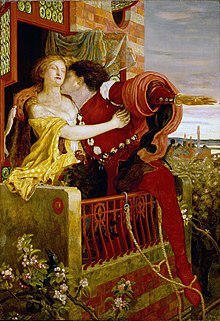Although styled an ‘Overture-Fantasy’ by the composer, the overall design is a symphonic poem in sonata form with an introduction and an epilogue. The work is based on three main strands of the Shakespeare story. The first strand, written in F-sharp minor, following Mily Balakirev‘s suggestion, is the introduction representing the saintly Friar Laurence. Here there is a foreboding of doom from the lower strings. The Friar Laurence theme is heard in F minor, with plucked strings, before ending up in E minor. The introduction is chorale-like.
Eventually a single first inversion B minor chord is passed back and forth between strings and woodwinds grows into the second strand in B minor, the agitated theme of the warring Capulets and Montagues, including a reference to the sword fight, depicted by crashing cymbals. There are agitated, quick sixteenth notes. The forceful irregular rhythms of the street music point ahead to Igor Stravinskyand beyond. The action suddenly slows, the key changing from B minor to D-flat (as suggested by Balakirev) and we hear the opening bars of the “love theme”, the third strand, passionate and yearning in character but always with an underlying current of anxiety.
The love theme signifies the couple first meeting and the scene at Juliet’s balcony. The English horn represents Romeo, while the flutes represent Juliet. Then the battling strand returns, this time with more intensity and build-up, with the Friar Laurence Theme heard with agitation. The strings enter with a lush, hovering melody over which the flute and oboe eventually soar with the love theme once again, this time loud and in D major, signaling the development section and their consummated marriage, and finally heard in E major, and two large orchestra hits with cymbal crashes signal the suicide of the two lovers. A final battle theme is played, then a soft, slow dirge in B major ensues, with timpani playing a repeated triplet pattern, and tuba holding a B natural for 16 bars. The woodwinds play a sweet homage to the lovers, and a final allusion to the love theme brings in the climax, beginning with a huge crescendo B natural roll of the timpani, and the orchestra plays homophonic shouts of a B major chord before the final bar, with full orchestra belting out a powerful B natural to close the overture.
https://en.wikipedia.org/wiki/Romeo_and_Juliet_(Tchaikovsky)
